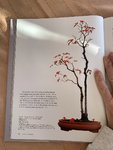The literati style is an elegant form of bonsai. The Japanese word “Bunjin” means “learned man” or “man of scholars.” The English word “literati” means “men of letters or learned men.” That’s it. The Chinese literati were well educated scholars who became boarded with the classics and decided to play with paintings. They painted according to their amusement, not necessarily realistic. Their quick whimsical paintings were to please themselves, and were not a commercial endeavor. Some Japanese artists appreciated this form and duplicated these paintings. Eventually the Japanese bonsai community decided to copy the Japanese literati painting forms with trees, which was originally for Chinese scholars. They turned to nature for forms.
Usually bonsai styles classified according to trunk shape (formal/informal upright, slanting and cascade.) However bonsai are also classified by the number of trunks (twin, triple, multiple,) method of planting (forest, rock, root connected,) and size (mame, shohin, medium, large.)
There are three styles of bonsai defined by “feeling” rather than a specific shape. The literati, windswept and broom styles do not have a typical defined form. They are loosely defined by the feeling they present to the viewer. And, perhaps the viewer’s interpretation can change as well. One might see a tree as a delicate literati bonsai while someone else might think it is too heavy or coarse.
A straight trunk tree with few delicate branches might present a literati feeling to some, while only a formal upright form is apparent to others. And, if all the branches are one side of the trunk, it might appear to be windswept. If all the branches are evenly distributed around the trunk, a broom style might be suggested. In the end, the trunk is absolutely straight, so it is of course a formal upright style according to the trunk shape.
Although almost any species can be trained in the literati style, some are better suited than others. For example, the Japanese maple has better characteristics than the Trident maple because of its fine texture and delicate foliage. Some of the dwarf cultivars of Japanese maples such as Shishigashira and Koto Hime grow tight and congested with curled leaves, not flat. These are more of a challenge to train in the literati style.
I just took a few quick photos of one of my Koto Hime Japanese maple bonsai container trained in the literati style from a cutting for over 30 years. This bonsai has a form which interests me. Like other well styled bonsai, it has multiple fronts, which I like because they can be easily exhibited in a specific area providing directionality to the display. I like the crossing lower trunk, and without this focal point branch the bonsai form would be dull, uninteresting and common. Take your pick as to the front. My front changes all the time.
But, please do not forget to enjoy and appreciate your bonsai. That is the most important aspect to this art. The name or label one puts on the bonsai is only one person’s opinion. The beauty is the most important aspect of bonsai in my opinion.
View attachment 220271View attachment 220272View attachment 220271View attachment 220273View attachment 220274View attachment 220275





